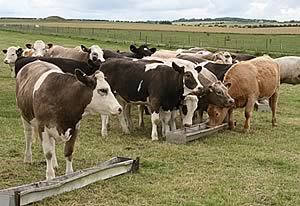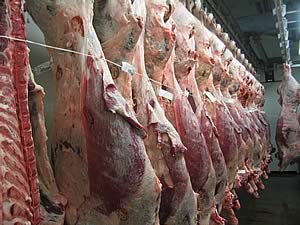|
23/11/07
Pneumonia-induced lung damage could be costing some cattle almost
74kg a year in lost lifetime growth potential with even moderate
damage resulting in animals losing 39kg over an 18 month beef
finishing system.
Blade Farmimg beef animals
 |
These startling figures - newly announced results [November 20th,
2007] from a major collaborative study between Schering-Plough
and Blade Farming - suggest that some producers may not be treating
cattle pneumonia as effectively as they could. The project also
highlights how better abattoir feedback can be used to improve
cattle pneumonia management regimes on farm.
In the study, 645 commercial beef animals from 15 units were examined at slaughter
for evidence of lung damage. Data on carcase weight, age and grade were also
collected to allow estimated daily live weight gains (EDLWG) to be recorded.
According to project co-ordinator Paul Williams MRCVS from Schering-Plough, the
research team recorded a significant level of pneumonia-induced lung damage in
the slaughtered cattle.
"Nearly half the cattle (48%) examined on the slaughter line had some level
of lung damage. But there was also huge variation between units, with all the
cattle from one particular farm having damaged lungs," he
said.
The researchers also established that the extent of lung damage
was strongly associated with reduced EDLWG. "The more lung
lobes that are affected, the greater the potential daily liveweight
gain loss and those cattle that had the most lung damage experienced
a significant reduction in EDLWG of 202g per day throughout their
entire lifetime.
"For the animals with any degree of lung damage (310 cattle), the average
reduction in weight gain over 14 months was 15kg - equivalent to a financial
loss of £16.90 per animal based on a live weight price of £1.10 per
kg. So the overall loss for this group of animals was potentially £5,239
- money the industry simply cannot afford to lose," Paul Williams
stressed.
Blade Farmimg beef carcases
 |
"In addition, those carcases with lung damage were significantly more likely
to have a lower conformation grade and so receive an even lower price," he
explained.
Blade Farming managing director Richard Phelps pointed out that
the study had convinced him that paying closer attention to minimising
pneumonia-induced lung damage could easily make some beef producers
an extra £40-£50 an
animal.
"Anything we can do to help our producers become more efficient is most
welcome and minimising the lung damage pneumonia causes is a good example of
where we can relay useful information down the chain," he
commented.
"All the cattle we take look healthy, but I've been surprised at the level
of undetected lung damage once the animals have been slaughtered.
This lung scoring trial work in the abattoir is now helping us assess just
how much lung damage diseases like pneumonia can cause. The feedback will be
able to help producers reassess early stage rearing issues and be more vigilant.
It's not just grading issues that we are concerned about.
"Apart from the mortality and treatment costs, lung damage from pneumonia
leads to lower growth rates and increases days on feed. For maximum supply chain
efficiency we want the opposite and innovations in the field of pneumonia treatment
are to be welcomed," Richard stressed.
Blade Farming consultant veterinary surgeon Rob Drysdale from the Westpoint Veterinary
Group stressed that whilst pneumonia prevention should be the number one objective
for all cattle producers, having an effective disease treatment protocol in place
is increasingly vital - and particularly one that prevents permanent lung damage
from occurring.
"Pneumonia infections can quickly damage lungs and once this happens the
animal will not be able to express its full genetic potential," he
stressed.
"This means that even if the affected animal survives it is likely to
have damaged lungs for the rest of its life, and this will reduce productivity
and growth."
To try and prevent pneumonia-induced permanent lung damage, Rob Drysdale always
recommends combination treatment, which involves fast, effective and proven antibiotic
therapy in conjunction with an anti-inflammatory.
"If your treatment is given early and combines an anti-inflammatory and
an antibiotic, it will reduce the amount of lung inflammation and fluid in the
lung air sacs (alveoli). Combination treatment will also reduce fever and pain
- which means the animal will be more likely to return to feeding quickly and
become productive again," he said.
Schering-Plough's Paul Williams explained that trials on commercial UK farms
with the latest pneumonia combination treatment show that the disease management
strategy is working well, but momentum needs to build if producers are to address
the potential growth setback problems identified in the lung study. Upgrading
pneumonia treatment objectives was the key message.
"In today's market, livestock farmers should expect their pneumonia treatment
to deliver both fast, visible recovery AND protect the lungs for future growth," he
stressed.
"Latest trial work suggests this can be achieved by the latest combination
pneumonia treatment. For example, 17 pneumonia outbreaks were monitored
last winter by commercial vets in practice. On the first veterinary visit,
calf temperatures were taken as an indication of the severity of the pneumonia
with depression and respiratory scores also recorded. The animals were then
treated with the Resflor pneumonia treatment that combines antibiotic and anti-inflammatory
therapy in a single injection. As little as six hours later the independent
vets re-visited the units to assess the success of the treatment.
"Across the 17 outbreaks, all calves that were particularly sick - identified
as those with an average enrolment temperature of 104ºF or over - recorded
an average fall of over 2ºF within six hours of the combination treatment
injection. This brought the temperature down to well below the accepted 103ºF
fever threshold.
"The respiratory and depression scores also markedly improved within six
hours. Farmers also reported visible improvements, early return to feeding and
marked animal recovery immediately post-treatment. Encouraging results that show
if producers are prepared to upgrade their pneumonia treatment protocol, lifetime
production potential need not necessarily be compromised," he
concluded.
 Meat Export Restrictions Finally Lifted for Most of GB Meat Export Restrictions Finally Lifted for Most of GB
 NFUS Urges Farmer and Public Vigilance for Avian Flu NFUS Urges Farmer and Public Vigilance for Avian Flu
 Farmers Offered Financial Help To Investigate Causes of Cattle Abortions Farmers Offered Financial Help To Investigate Causes of Cattle Abortions
|



